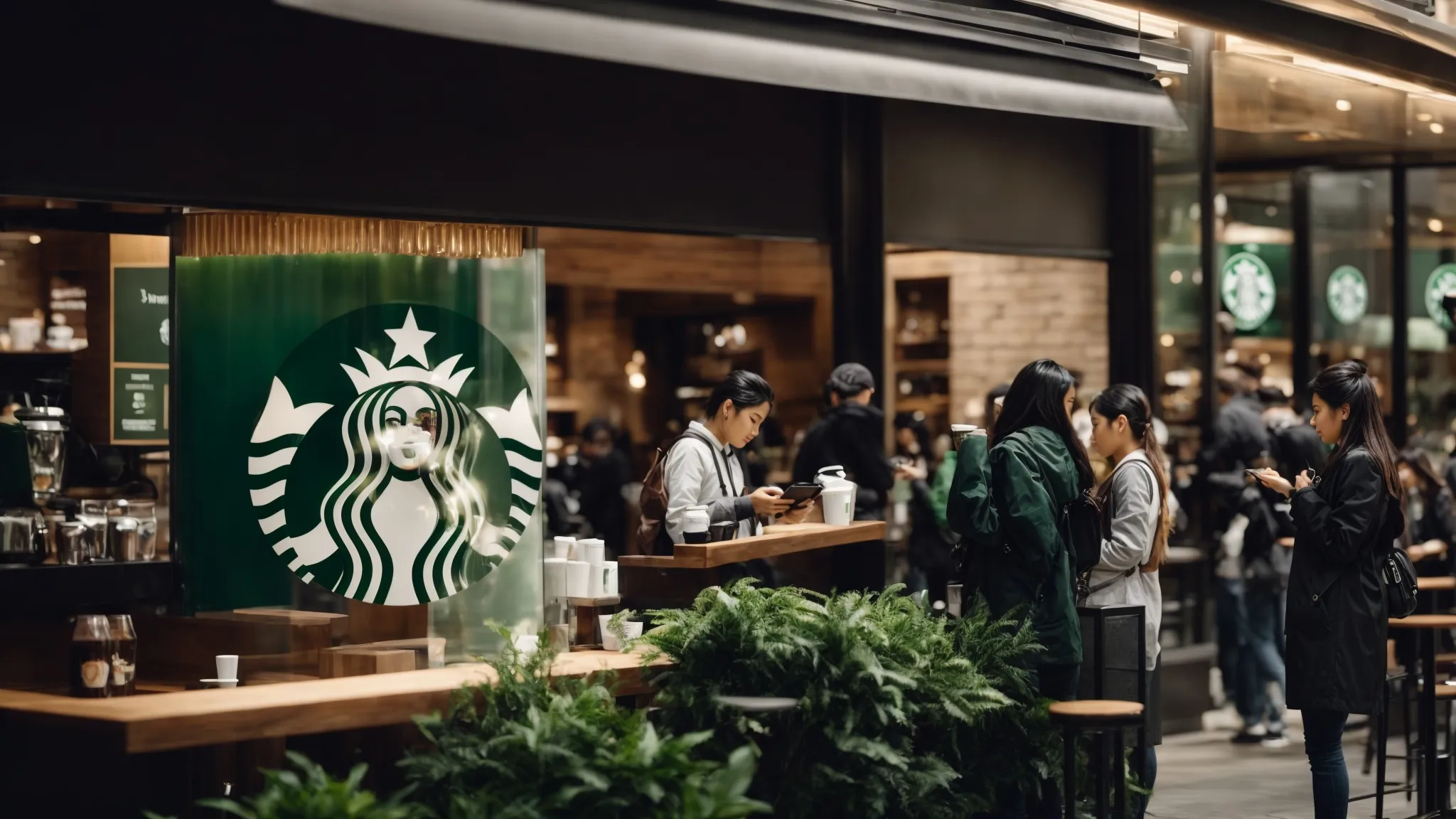Big Brand Local SEO Case Studies Uncovered
Big Brand Strategies: Inside Local SEO Case Studies Local SEO has become the battleground where industry titans like Starbucks and Walmart vie for supremacy in digital dominance. […]
Big Brand Strategies: Inside Local SEO Case Studies
Local SEO has become the battleground where industry titans like Starbucks and Walmart vie for supremacy in digital dominance.
These companies understand that a robust local SEO strategy ensures they appear in search results precisely when the customer’s intent and proximity align with their offerings.
From the meticulous keyword targeting of McDonald’s to the strategic content placement by Apple, their methods are a masterclass in enhancing online visibility for multiple locations.
Inside the precise mechanics of Home Depot’s SEO maneuvers to IKEA’s clever structuring for local relevance, there is much to learn from these frontrunners.
Keep reading to unlock the secrets of their success and how these strategies can be adapted for any business eager to conquer local search.
Key Takeaways
- Local SEO Strategies Are Pivotal for Connecting With Regional Markets and Enhancing Brand Visibility
- Tailoring Content to Local Design Trends and Community Events Boosts Both Online Engagement and in-Store Traffic
- Strategic Use of Local Inventory Ads and Personalized Mobile Experiences Can Significantly Impact Local Search Rankings
- Incorporating Local Culture and Language Into Marketing Efforts Strengthens a Brand’s Connection With Community Values
- Monitoring Competitor Strategies Informs the Development of Proactive, Location-Based SEO Initiatives
Decoding the Local SEO Triumph of Starbucks

In the dynamic landscape of digital marketing, the mastery of local SEO stands as a testament to the strategic prowess of leading brands such as Starbucks.
The coffeehouse giant’s approach to optimizing its local presence provides an instructive case study for businesses aiming to penetrate the neighborhood market.
Starbucks exemplifies the effectiveness of a comprehensive local SEO strategy – from harnessing the power of Google My Business for solidifying its local footprint, to the precision of incorporating location-based keywords for dominating regional searches.
Moreover, the company’s savvy utilization of customer reviews bolsters its local credibility, while meticulously crafted local store pages elevate its visibility to consumers.
Lastly, Starbucks’ deliberate adoption of social media strategies tailored to local communities underscores the importance of engagement in building an enduring bond with patrons.
Altogether, these elements converge to create an SEO architecture that not only attracts a user but ensures their return.
This exploration will unravel how each of these tactics coalesce to bolster a brand’s local search prominence and foster greater connectivity with its target audience.
Establishing a Robust Local Presence With Google My Business
Starbucks enhances its local visibility by strategically leveraging Google My Business to project a comprehensive portrayal of each store. The interface’s ability to integrate vital details such as operating hours, address, and contact information serves to cultivate trust with users actively seeking local coffee experiences.
Proactive engagement with the tool’s review feature amplifies Starbucks’ identity as a responsive, community-oriented brand. The seamless integration of user feedback into local listings not only reflects commitment to service excellence but also significantly contributes to the organic elevation of local search rankings.
Using Location-Based Keywords to Dominate Local Searches
Starbucks’ utilization of location-based keywords exemplifies an astute understanding of how to maximize local search visibility. By incorporating city names, neighborhood references, and local landmarks within their website content and metadata, Starbucks ensures its presence is felt on search engine result pages for geographically specific queries.
The refinement of local keyword strategy has propelled Starbucks’ search engine prominence, manifesting in a surge of local foot traffic and online visibility:
- Strategic incorporation of regional vernacular to resonate with the local audience
- Continuous analysis and adaptation of keyword performance metrics
- Deployment of location-centric ad campaigns to amplify reach
This tactical approach to SEO positions Starbucks not merely as a global entity but as a neighborhood staple, attentive to the distinctive needs and search habits of the local user base.
Leveraging Customer Reviews for Local Credibility
In the intricate ballet of local SEO, Starbucks’ sensitivity to customer feedback has been instrumental in fortifying its local influence and trustworthiness. The brand’s dedication to not only collecting but also responding to customer reviews solidifies its relationship with the local clientele and improves its organic search rankings through active user engagement.
By showcasing positive customer experiences prominently on their local listings, Starbucks taps into the powerful narrative of social proof: where prospective customers find reassurance in the endorsements of their peers. This strategy, meticulously implemented across their digital presence, becomes a cornerstone of the brand’s local SEO tactics:
| Strategy Element | SEO Impact | Customer Experience |
|---|---|---|
| Review Collection | Enhances rankings and visibility | Encourages user participation and transparency |
| Responding to Reviews | Signifies active engagement | Builds consumer trust and brand loyalty |
| Social Proof | Attracts new customers | Offers reassurance through community endorsement |
Implementing Local Store Pages to Enhance Findability
At the forefront of local search optimization, Starbucks has adeptly implemented local store pages, each acting as a mini-hub for pertinent store-specific information. These dedicated pages provide an optimal user experience by offering quick access to hours of operation, event listings, and local promotions, thereby enhancing the online findability of individual stores.
This strategic move subtly guides the user from a general brand search to the doorstep of their nearest Starbucks location. It showcases how detailed attention to the unique digital real estate of each store enriches the overall brand narrative:
- Local store pages tailored to community needs provide a targeted user experience.
- Enhanced store-specific content boosts visibility and drives local footfall.
Adopting Local Social Media Tactics for Community Engagement
Starbucks’ approach to local SEO is exemplified in its tailored social media tactics, designed to nurture community engagement. By creating location-specific social media pages, Starbucks directly communicates with customers in their community, sharing local events, promotions, and store news that resonate with the local clientele’s interests.
This direct line to the heart of the community cements Starbucks’ commitment to regional relevance, while also reinforcing its online presence in local search results. The engagement these tactics drive contributes to the ongoing conversation between the brand and its followers, transforming each local store from a point on the map into a hub of community activity.
Walmart’s Winning Local SEO Game Plan Revealed

As businesses strive to dominate the local search landscape, Walmart’s adept maneuvers provide a blueprint for success.
Overseeing myriad store locations, Walmart channels a sophisticated approach to search engine optimization that transcends mere corporate prowess, echoing tactics often reserved for nimble local enterprises.
This subsection unfolds the layers of Walmart’s local SEO strategy, shedding light on how the retail behemoth optimizes its store locator pages for heightened relevance, embraces structured data to bolster search visibility, and weaves localized content that resonates across diverse regions.
Furthermore, Walmart’s deployment of strategic local link-building enhances its authoritative stance, while its methodical local citation management ensures accuracy and consistency across the digital spectrum.
Each element exemplifies the multifaceted approach necessary to forge and sustain a commanding local SEO presence.
Optimizing Store Locator Pages for Local Relevance
Walmart meticulously fine-tunes its store locator pages, ensuring each one is optimized for maximal local relevance. By embedding specific geographic details and keywords, these pages become more discoverable to consumers searching for nearby shopping options, thereby improving Walmart’s local search footprint.
The retail titan has successfully transformed its store locator feature into a seamless local search asset, integrating maps, directions, and even inventory levels that are tailored to match the user’s immediate locale. This strategic optimization underscores a commitment to delivering a convenient and localized shopping experience, directly serving the search intent of its regional customer base.
Enhancing Local Search Visibility With Structured Data
Walmart’s meticulous implementation of structured data marks a significant leap in enhancing local search visibility. The brand’s adoption of schema markup for store locations ensures that search engines can quickly comprehend and display key information in rich snippets, lifting Walmart’s visibility on the search engine results page.
- Structured data is integrated into Walmart’s online store listings to define store attributes explicitly.
- Search engines leverage this data to create rich results, which amplifies Walmart’s presence in local searches.
- The utilization of schema markup contributes to the accuracy and detail presented to searchers, driving relevant foot traffic to the store.
By capitalizing on the clarity structured data provides, Walmart delivers precise and contextually relevant information to users performing local queries. This strategic use of detailed and organized data ensures Walmart appears prominently in location-based searches, directly addressing the user’s intent for localized information.
Crafting Localized Content for Regional Appeal
Walmart amplifies its regional appeal by crafting localized content that reverberates with the nuances of each community it serves. This commitment to region-specific storytelling allows the retailer to forge a genuine connection with a diverse customer base, with local events, traditions, and cultural references infusing each piece of content.
By aligning online content strategies with regional preferences and interests, the company effectively tailors the shopping experience to mirror the local ethos:
- Incorporating local language and colloquialisms to resonate authentically with the community.
- Highlighting locally relevant products and services to demonstrate community integration.
- Engaging with regional influencers and events to amplify local relevance and reach.
The precision of Walmart’s Content Strategy not only enhances user engagement but also contributes to a tailored online presence rooted deeply within each locale it inhabits.
Employing Local Link-Building Strategies for Authority
In the realm of local SEO, Walmart bolsters its authority with judicious local link-building. The company fosters connections with locally recognized sites, establishing a network of relevant backlinks that enhance its digital reputation and search engine standings.
- Walmart identifies and partners with influential local websites to build a network of backlinks.
- The brand pursues guest posting opportunities on prominent local platforms to deepen its community roots.
- Walmart’s participation in community events contributes to natural link acquisition, bolstering its local SEO strategy.
This strategy is not simply about amassing a quantity of links but focuses on the quality and local significance of each connection. By cultivating authoritative local backlinks, the retail giant underscores its commitment to each market it serves and earns the trust of both search engines and shoppers alike.
Developing an Effective Local Citation Management Approach
Walmart’s deft handling of local citation management sets a gold standard for ensuring data consistency across the digital ecosystem. By regularly auditing and updating store details on online directories and maps, the retail juggernaut guarantees its information remains accurate, enhancing search reliability for customers.
The company’s methodical approach to citation management effectively mitigates the risk of consumer misdirection, fortifying its local SEO impact. This practice not only aligns with customer expectations for precision but also reinforces Walmart’s authority and trustworthiness in the eyes of the ever-discerning search engine algorithms.
How McDonald’s Serves Up Local SEO Success

Within the competitive sphere of fast-food giants, McDonald’s excels at concocting a delectable local SEO strategy that caters precisely to the tastes of its regional audiences.
With a finger on the pulse of digital evolution, McDonald’s recipe for success involves an alchemy of prioritizing local keywords, personalizing mobile experiences, and seasoning their offerings with data-driven insights.
The brand’s commitment to fostering a strong local online presence is exemplified through meticulously crafted regional campaigns and the seamless integration of in-store activities with digital initiatives.
These endeavors underscore McDonald’s focus on enhancing user engagement and optimizing each customer’s journey from online searches to dine-in or drive-thru experiences.
Prioritizing Local Keywords in Digital Content Strategies
McDonald’s understands that engaging a local audience hinges on the nuanced integration of local keywords within its online content. By embedding region-specific terms and references throughout its web pages, the fast-food giant enhances its relevance to local search queries, anchoring its place in the geographic lexicon of its diners.
The brand’s meticulous content strategy employs a mix of neighborhood jargon, local event mentions, and community-specific highlights, ensuring that each digital touchpoint resonates with the locality it serves. McDonald’s advanced use of local keywords permits the brand to rise to the top of search results, capturing the attention of an audience in search of a familiar and convenient dining experience:
| SEO Aspect | Localized Approach | Impact |
|---|---|---|
| Keyword Integration | Inclusion of area-specific terms | Boosts discoverability in local search |
| Community Engagement | References to local events and culture | Strengthens community connection |
| Content Relevance | Unique regional content specials | Drives local foot traffic and loyalty |
Localizing Mobile App Features for Increased Engagement
McDonald’s astute focus on mobile app personalization serves as a critical cog in their local SEO arsenal. By tailoring app features to reflect local flavors, events, and deals, they manage not only to lure in customers but also to keep them engaged with geographically relevant offerings that hit close to home.
Through the integration of store-specific promotions and location-triggered notifications, the McDonald’s app provides a compelling, user-friendly experience that aligns with the routines and preferences of local users. This hyper-localized strategy transforms their mobile app into a powerful tool for boosting local search rankings while fostering a deeper connection with the community.
Tailoring Local Offers and Promotions Using SEO Insights
In leveraging sophisticated SEO insights, McDonald’s finely tunes its promotional efforts to align with the search behaviors and preferences of local markets. By dissecting search query data and consumer trends, the company crafts offers and incentives that prove irresistible to the local palate.
This deep dive into the analytics not only informs their specials and deals; it allows McDonald’s to rotate its menu offerings dynamically, ensuring that each locale is greeted with deals that have risen from a blend of regional demand and strategic SEO analysis:
| SEO Insight | Local Promotion Strategy | Consumer Benefit |
|---|---|---|
| Search Trend Analysis | Customized Discounts | Tailored Deals Meet User Expectations |
| Location Data | Region-Specific Offerings | Menu Relevance Increases Store Visits |
| Consumer Behavior Tracking | Time-Sensitive Campaigns | Deals Synced with Eating Habits |
Through careful application of search data, McDonald’s not only maximizes local engagement but also heightens the efficacy of its marketing spend, ensuring that promotional resources are channelled into campaigns that yield substantial local traction.
Building Local Landing Pages for Regional Campaigns
McDonald’s harnesses the power of region-specific landing pages to ensure its marketing campaigns speak directly to the local user. By creating unique pages for various locales, the brand amplifies its regional relevance, directly channeling the searcher’s intent toward its strategically situated eateries.
With each landing page crafted to highlight local specials, events, and store-specific information, McDonald’s secures a top position on search engine results pages (SERPs). This targeted approach not only boosts organic reach within the community but also streamlines the customer’s path to the nearest McDonald’s, thus solidifying the brand’s local market penetration.
Integrating Local Store Initiatives With Online Efforts
McDonald’s strategic merging of local store campaigns with online initiatives manifests a seamless user journey from digital engagement to physical visitation. This convergence creates a holistic brand experience that effectively translates online interest into in-store actions and patronage, driving regional store performance through a unified marketing front.
By incorporating digital promotions that mirror in-store events, the fast-food titan crafts a cohesive narrative that resonates with local communities. McDonald’s keen understanding of the synergy between online presence and physical promotions ensures that local marketing efforts are not siloed, but rather work in concert to amplify the brand’s local sway and appeal.
Apple’s Approach to Dominating Local Searches

In a landscape where digital touchpoints intersect with physical locales, Apple’s innovative approach to local search engine optimization offers invaluable insights into brand strategies that enhance visibility at a granular level.
By embracing hyper-local SEO tactics, curating in-store experiences based on localized data, customizing event listings to drive local traffic, partnering with regional influencers, and honing local public relations initiatives, Apple showcases how a synergistic integration of various tactics can fortify a brand’s local presence.
These strategies unfold across Apple Stores, each serving as a case study in employing meticulous SEO methodologies to dominate local searches and connect more intimately with the regional demographics that dictate the success of each retail space.
Implementing Hyper-Local SEO for Apple Stores
Apple Stores stand as exemplars of hyper-local SEO execution, with each location deftly tailoring its online presence to the nuances of its specific geographic area. The implementation includes meticulous attention to local keywords within website content, a focus that ensures Apple Store pages rank high for locality-driven searches.
Insights gleaned from in-depth local market analysis drive this customization, fostering an online identity for each store that mirrors the community it serves. These data-driven tactics are integral to connecting users with their nearest Apple Store:
- Harvesting and implementing local search data to refine SEO strategies.
- Crafting store-specific content that resonates with the regional audience.
- Optimizing online listings with localized information, events, and promotions.
Enhancing in-Store Experiences With Local SEO Insights
Apple ingeniously harnesses local SEO data to cultivate in-store experiences that resonate with the local community. By analyzing search behaviors and footfall patterns, Apple tailors its in-store offerings, ensuring that the product displays and interactive sessions reflect the preferences and interests of the local market.
The integration of local cultural nuances and events into the store environment is a testament to Apple’s commitment to providing a personalized shopping experience. This strategy acts as a magnet, drawing in customers through a curated ambiance that aligns seamlessly with the community’s identity and lifestyle.
Customizing Event Listings for Local Search Optimization
In a strategic push for local search optimization, Apple customizes event listings within its stores to catch the interest of the local searcher. By spotlighting community-focused events and workshops relevant to each store’s regional flavor, Apple reinforces local engagement and drives foot traffic effectively.
- Listing coding workshops coinciding with regional tech festivals
- Featuring artists and musicians in stores located in culturally vibrant neighborhoods
- Hosting local entrepreneurs for in-store business sessions in corporate-heavy districts
The firm’s effort in localizing event listings goes beyond mere schedule posting; it’s about tuning into the heartbeat of the area and syncing with its rhythm. Each event becomes a targeted beacon, shining bright on search engines, thereby not only fulfilling but also predicting community interests.
Leveraging Local Influencer Partnerships for SEO Gains
Apple has strategically embraced local influencer partnerships to elevate its local search engine optimization efforts. By aligning with regional thought leaders and personalities who boast dedicated followings, the tech titan enhances its local relevance and visibility, fostering a symbiotic relationship that translates into higher search rankings and customer engagement in specific markets.
These collaborations extend beyond superficial endorsements, as influencers serve as conduits for authentic brand narratives that resonate on a community level. Their localized content and trusted voice amplify Apple’s presence in the digital space, guiding a more targeted audience toward the brand’s local stores and initiatives through influential SEO leverage.
Perfecting the Art of Local PR for SEO Benefits
In the sphere of local SEO, Apple leverages the power of public relations to elevate its proximity to potential customers. The company’s nuanced execution of local PR campaigns employs region-specific narratives that bolster organic search results, amplifying the brand’s local resonance and reinforcing its authority within community confines.
This strategic application of local PR not only garners media coverage but also drives local search engine relevance. By aligning its storytelling with the cultural and economic characteristics of each region, Apple’s approach to local PR extends beyond mere publicity—serving as a potent tool that directly aids in improving search engine optimization and fostering community engagement.
Inside Home Depot’s Local SEO Blueprint

The modern consumer’s journey to purchase, particularly in the realm of home improvement and DIY, often begins with a digital foray into local search queries.
Home Depot, a leading entity in this sector, harnesses an innovative array of strategies designed to secure its dominance within the competitive landscape of local SEO.
The brand’s blueprint is multifaceted, incorporating optimized DIY guides, local inventory ads, community-focused project pages, seasonal keyword promotions, and vigilant competitor tracking.
Each serves as a vital cog in the machinery of Home Depot’s tailored approach, specifically engineered to enhance visibility, increase in-store traffic, and elevate its brand above the local competition.
Localizing DIY Guides and Home Improvement Tips
Home Depot’s savvy approach to local SEO extends into the realm of content creation, specifically through the localization of DIY guides and home improvement tips. Recognizing the unique climates, housing styles, and regional regulations, the company tailors its advice, ensuring homeowners receive the most relevant information for their specific area.
The insightful crafting of these targeted resources serves to enhance user experience on Home Depot’s website, which in turn bolsters the brand’s search rankings and increases its value as a local authority in home improvement:
- Developing region-specific DIY tutorials that align with local building trends and materials.
- Curating seasonal home maintenance guides that cater to the geographical and climatic needs of customers.
- Providing area-based solutions that tackle common local home repair challenges, thereby building customer reliance and trust.
Utilizing Local Inventory Ads to Drive Foot Traffic
Home Depot’s integration of Local Inventory Ads has proven to be a game-changer for bridging online browsing and in-store purchasing. These ads provide real-time availability of products specific to regional stores, directly addressing the convenience factor that can tip the scales in favor of a store visit.
By strategically placing these Local Inventory Ads in search results, Home Depot ensures that potential customers are only a click away from viewing items they can immediately pick up locally. This strategy not only streamlines the shopping experience but also drives substantial foot traffic to brick-and-mortar locations, tapping into the immediacy of consumer needs.
Creating Local Community Project Pages for SEO
Home Depot distinguishes itself in the local SEO space by establishing community project pages that resonate with homeowners in specific areas. These pages are adeptly designed with SEO in mind, featuring localized content that addresses the unique needs and interests of the community, thereby enhancing the brand’s relevance and searchability in regional search queries.
The strategic curation of these pages serves as digital anchors, connecting online explorers with tangible community projects that Home Depot supports or initiates. By doing so, the enterprise not only demonstrates its investment in local development but also strengthens its digital footprint, leading to improved local SERP performance and community engagement.
Focusing on Local Keywords for Seasonal Promotions
Home Depot’s strategy notably includes a focus on local keywords tailored to seasonal promotions, ensuring that their offerings are prominently displayed to a location-specific audience during peak times. This technique underscores the brand’s commitment to providing time-sensitive solutions that resonate with the seasonal needs of each community.
By harnessing regional search trends and weather patterns, Home Depot aligns its product showcases with consumer behavior, effectively capturing the intent of local searches during critical home improvement periods. This tactical application of SEO principles drives traffic both to their digital platforms and to physical store locations where customers are ready to transform their seasonal plans into action.
Tracking Local Competitor Strategies for SEO Advantage
Within the fierce arena of local SEO, Home Depot’s surveillance of competitor strategies delivers a profound edge, inducing a sophisticated layer to its expansive SEO playbook. Thorough analysis of how rival brands engage local audiences and gain search traction enables Home Depot to refine its initiatives, ensuring its stores are consistently outmaneuvering competitors in search rankings.
Home Depot employs this intelligence to cultivate robust SEO tactics that are not only responsive but proactive in capturing local market share. The synergy between competitive insights and strategic action crystallizes into enhanced visibility and a fortified brand presence:
- Distilling competitor keyword successes to optimize its own local SEO efforts.
- Pioneering innovative location-based promotions grounded on competitor gap analysis.
- Adjusting on-page and off-page SEO elements to eclipse competitor local ranking factors.
How IKEA Assembles a Strong Local SEO Presence

In the highly competitive realm of home furnishing and decor, IKEA has masterfully constructed a formidable local SEO framework that propels their brand to the forefront of locality-specific search results.
Fully aware that the aesthetic appeal can significantly vary from area to area, IKEA tailors its digital content to echo local design trends, creating a sense of personalization and relevance for the customer.
The brand’s strategic emphasis on local showroom pages, backed by a robust multilingual SEO strategy, ensures that regardless of language or location, shoppers encounter a seamless, culturally resonant online experience.
This tailored approach is further augmented by streamlining features like ‘Click and Collect’ to cater to the locality’s shopping behaviors, while the infusion of local culture into their marketing narrative serves to enhance IKEA’s connection with each unique market, forging stronger SEO resonance and elevating the brand’s local engagement.
Tailoring Room Inspirations to Local Design Trends
IKEA’s meticulous adaptation of room inspirations to reflect local design trends underscores its prowess in local SEO. The company keenly observes regional aesthetic preferences and integrates these nuanced styles into its online showroom, ensuring the digital experience feels tailored and personal for shoppers in every market.
This focused customization not only heightens IKEA’s relevance in local search queries but also fosters a deeper brand connection. Users finding their local design idiosyncrasies mirrored in IKEA’s product presentations are more likely to engage, reinforcing the brand’s position as a go-to source for home furnishing solutions that resonate with local tastes.
Cultivating Local Showroom Pages for Maximum SEO Value
IKEA’s dedication to optimizing local showroom pages exemplifies its shrewd deployment of local SEO tactics. Recognizing the crucial role of location-specific content, the brand meticulously ensures that each showroom page offers a user experience uniquely crafted for the community it addresses, enhancing the precision with which the brand appears in local search queries.
The result of this fine-tuned strategy is a robust online presence that captures the attention of users seeking specialized solutions aligned with the aesthetic sensibilities of their locale. With IKEA’s strategy, showroom pages transcend mere digital catalogues, evolving into vibrant portals that showcase a deep understanding of local trends and user preferences:
| SEO Element | Local Showroom Page Feature | User Experience Impact |
|---|---|---|
| Local Content Optimization | Regionally-inspired room settings | Engages users with familiar designs |
| Geo-targeted Keywords | Location-specific information and offers | Ensures showroom pages rank for local searches |
| User Interface and Navigation | Streamlined design with intuitive local store finder | Facilitates efficient user pathway to in-store experiences |
Developing a Multilingual SEO Strategy for Diverse Locales
In the global marketplace, IKEA’s meticulous application of a multilingual SEO strategy reflects a deep understanding of diverse locales. This initiative ensures that the brand’s online content resonates with accuracy in multiple languages, thereby increasing the accessibility and relevance to a wide spectrum of users seeking local context in their native tongue.
By adapting keyword research and optimization to encompass a variety of languages, IKEA captures the essence of local search intent across different regions. This focused effort not only solidifies the brand’s footprint in international markets but also enhances user engagement by providing a culturally and linguistically tailored online experience.
Enhancing the ‘Click and Collect’ Feature for Local Efficacy
IKEA’s integration of the ‘Click and Collect’ feature is a masterful stroke in its suite of local SEO tactics, designed to streamline the shopping process for customers within specific locales. This service allows buyers to reserve products online and collect them at a time that suits their convenience, resonating with the immediacy and personalized needs of the local shopper.
The ‘Click and Collect’ system is not only a testament to IKEA’s commitment to customer-centric service but it also serves as an SEO booster by driving local online searches towards physical store interactions. As users search for the availability of items within their vicinity, the feature ensures IKEA’s local pages receive increased visibility and engagement, solidifying the brand’s presence in the local market.
Adopting Local Culture in Marketing for SEO Resonance
Implementing a deep understanding of local culture into marketing initiatives, IKEA effectively maximizes SEO resonance with audiences in specific regions. Such strategies encompass creating campaigns that celebrate local festivals, traditions, and design aesthetics, embedding the brand within the fabric of the community and elevating search engine affinity through culturally relevant keywords.
These culturally infused marketing efforts bridge the gap between global brand identity and local consumer preferences, driving both online engagement and in-store visits. As IKEA tailors its narrative to echo the community’s unique lifestyle and values, it achieves a synergistic blend of brand consistency and local adaptation that significantly bolsters its local SEO presence.
Frequently Asked Questions
How did Starbucks achieve success with its local SEO strategies?
Starbucks sculpted its success in local SEO by deploying a robust local search strategy that emphasizes the optimization of location-specific landing pages, integration with Google My Business, and encouraging customer reviews to climb local search rankings. The industry giant honed in on hyperlocal keyword targeting whilst engaging customers on social media platforms and through mobile app features – key moves that have ingratiated the brand with both search engines and localized customer bases.
What approach did Walmart take to win the local SEO game?
Walmart capitalized on a robust Local SEO strategy by ensuring accurate, updated local listings across multiple platforms and leveraging user reviews to improve local search visibility. The retail giant also optimized its localized website content to resonate with regional audiences, which in turn strengthened its local search rankings.
How does McDonald’s serve up local SEO success in its marketing efforts?
McDonald’s achieves local SEO success by meticulously optimizing their website and local listings for specific target keywords related to their brand, coupled with providing relevant, location-based content that resonates with their audience. Additionally, by harnessing a powerful local SEO strategy that includes consistent NAP (Name, Address, Phone number) data across directories, engaging social media business pages, and gathering positive customer reviews, the company ensures prominent visibility in local search results.
What is Apple’s strategy for dominating local searches?
Apple’s strategy for dominating local searches hinges on the optimization of its location-specific services, such as Apple Maps and Siri, ensuring seamless integration with local business listings and user preferences. Leveraging its vast ecosystem of devices and services, the company continually refines its algorithms to present the most relevant and personalized local search results to its users.
How does Home Depot implement its local SEO blueprint to attract customers?
Home Depot executes a robust local SEO strategy by optimizing its online presence for local search through precise location-based keywords, ensuring up-to-date listings across multiple directories, and encouraging customer reviews to enhance visibility. This multifaceted approach promotes engagement with the audience in regional spheres, driving foot traffic and local online conversions.
How can I leverage content marketing to enhance my local SEO efforts?
Content marketing plays a pivotal role in local SEO success, as demonstrated by big brands like Starbucks and McDonald’s. By creating location-specific landing pages, generating customer reviews, and engaging with the target audience on social media platforms, businesses can boost their local search rankings and establish a stronger connection with their local customer bases. The integration of relevant, location-based content is a key element in this strategy, aligning with the preferences and interests of regional audiences.
What role does social media strategy play in the local SEO game, and how do major brands incorporate it into their tactics?
Social media platforms are integral to local SEO strategies, providing a direct avenue to connect with audiences. Major brands such as Starbucks and McDonald’s showcase the importance of engaging followers on social media by sharing updates, responding to comments, and participating in discussions. This interactive approach not only fosters a sense of community but also signals to search engines that the brand is actively involved and relevant in local conversations, positively impacting local search rankings.
Can you provide insights into the significance of webinars and presentations in the context of local SEO and digital marketing?
Webinar presentations serve as valuable tools for sharing expertise and insights, as demonstrated by successful digital marketing strategies. Platforms like Starbucks and McDonald’s often utilize webinars to showcase case studies, discuss industry trends, and share best practices. By doing so, these brands position themselves as experts in their field, attracting attention not only from their target audience but also from search engines, thus influencing local search rankings positively.
How do B2B marketers apply local SEO strategies to their advantage, and what are the key elements in their approach?
B2B marketers can benefit from local SEO by tailoring their strategies to target specific industries and regions. By optimizing for relevant target keywords, ensuring accurate business listings, and participating in industry-related discussions, B2B marketers enhance their local search visibility. Starbucks and McDonald’s provide inspiration by showcasing how even in the B2C space, understanding and catering to the unique needs of local audiences can be a powerful tool in achieving SEO success.
What role does email marketing play in complementing local SEO efforts, and how can businesses effectively integrate the two?
Email marketing is a complementary tool in the arsenal of brands like Home Depot when executing local SEO strategies. By incorporating location-specific content, promotions, and updates in newsletters, businesses can strengthen their connection with their target audience. This personalized approach not only enhances customer engagement but also contributes positively to local search rankings by signaling relevance and responsiveness to the local audience’s needs and interests.
Conclusion
The detailed exploration of the local SEO strategies employed by major brands such as Starbucks, Walmart, McDonald’s, Apple, Home Depot, and IKEA yields a clear conclusion: meticulous, localized search optimization is crucial for enhancing brand visibility and fostering consumer engagement at a community level.
These brands showcase the power of leveraging Google My Business, local keywords, customer reviews, and social media to create strong local ties and drive foot traffic.
Moreover, by tailoring content, utilizing local influencers, and managing citations, they effectively resonate with local audiences and secure higher rankings in local searches.
Through smart and strategic planning focused on meeting the unique demands of regional markets, these big brands demonstrate that a dynamic and localized SEO approach is a critical component of digital success, serving to bridge the gap between global presence and local specificity.















































































